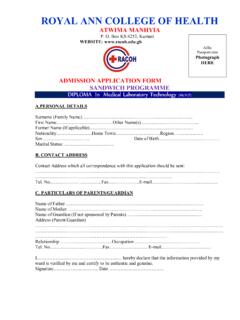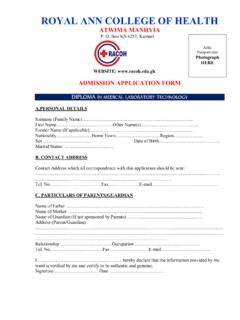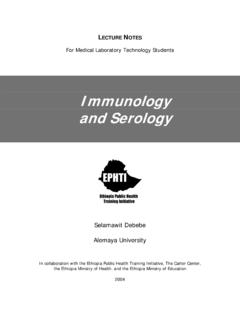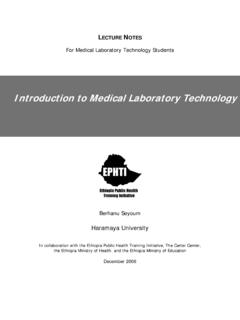Transcription of DIPLOMA IN MEDICAL LABORATORY …
1 DIPLOMA IN MEDICAL LABORATORY technology (DMLT) course curriculum GENERAL INFORMATION 1. The Duration of DIPLOMA course of MEDICAL LABORATORY technology (DMLT) is two years. 2. The minimum educational qualification for selection of trainees for the DIPLOMA course of MEDICAL LABORATORY technology is +2 Science with Biology as one of the subject. 3. Total marks of the DMLT course is 1000. 4. Minimum pass mark of the trainees if 50% in Theory, 50% in Oral & 50% in Practical. 5. 1st Class mark is 60% in Theory, Practical & Oral in aggregate respectively. 6. Less than 40% either in Theory or in Practical or in Oral in any paper will be treated as unsuccessful (Fail).
2 PART-1 BASIC course ON MEDICAL LABORATORY technology Duration - 4 Months Subject 16 weeks (110hrs) 1. Anatomy (Theory+ Practical) 20hrs+10hrs 2. Physiology (Theory + Practical) - 20hrs+10hrs 3. Comm. Medicine, Computer Science+Statistics(Theory+ Practical) 20hrs+10hrs 4. Pharmacology (Theory) 20hrs EXAM - First Total Marks 200 Theory - 140 + Practical 60 Theory Paper I Anatomy 35 Physiology 35 Theory Paper II Comm. Medicine, Computer Science + Statistics 35 Pharmacology 35 Practical Anatomy 20 Physiology 20 Comm. Medicine 20 SECTION-I ANATOMY Total period - 4 months Theory 20 hrs.
3 Marks - 35 1. Introduction to the subject - Anatomical position, common planes & Anatomical terms. -Different branches of Anatomy. 2. Histology -Typical animal cell (Structure & Function) -4 primary tissues (Classification & function) 3. Skeletal System - Axial and appendicular bones -Joints &movements 4. Skin, Fascia and Muscles & Tendons 5. Circulatory System Heart, Blood Vessels, Lymphatic & -Spleen, Thymus & Tonsils 6. Respiratory System- Nose, Pharynx, Larynx, Trachea, Bronchi Lungs and Pleura 7. Digestive System- Alimentary canal (different parts)-Liver, Gall Bladder, Pancreases Peritoneum 8.
4 Urogenital System- Different parts of urinary system -Different parts of Male & Female genital -System (Internal & External Genitalia) 9. Special Senses& General Sensibilities- Eye & Vision-Ears, Hearing & Equilibrium, -Taste & 01 factory sensations, General Sensibilities like touch, pain, temperature. 10. Central & Peripheral nervous system- Brain & Spinal Cranial & Spinal Autonomic Nervous System. 11. Regional Anatomy (Only Demonstration) Extremities, Head & Neck, Thorax,Abd. & Pelvis, Surface Anatomy, Important Blood Vessels, Important Nerve, Important Muscles for Injection. Practical 10hrs Marks - 20 SECTION-II PHYSIOLOGY Total Period 4 months Theory 20 hrs.
5 Mark 35 1- Blood- Composition and general function of of blood cells - normal counts & of congratulation, Fluid, Formation, Composition & Function. Importance of blood groups composition & function of lymph. 2- Reparatory System -Name of structures involved in respirations and their function. External and internal respiration. How inspiration, expiration are brought about Transport of O2 and CO2 in the blood. Definition of respiratory rate, Tidal volume, vital capacity, Hypoxia. 3- Excretory System-Functions of Kidney, Nephron - Functions of Glomerulus and tubules, compositions of Urine, normal& abnormal.
6 Skin- Function of Skin. 4- Digestive System-Composition and functions of saliva, mastication and deglutition. Functions of stomach, composition of gastric juice. Pancreatic Juice, Bile and Digestion of food by different Enzymes, Absorption and Defecation. 5- Endocrine-glands-Definition of endocrine gland, Names of the endocrine gland and the hormone secreted by actions of such Hormones. 6- Reproductive System-Name of primary and accessory organs in male and female. Name of secondary sexual characters in male and female. Function of ovary-formation of ova, actions of ovarian hormone, menstrual of Testes-Spermatogenesis and secretions of testosterone.
7 Fertilization Vasectomy and tubectomy. Practical 10hrs Marks - 20 Note: The teaching of Anatomy & Physiology should be coordinated so that structure and function of different parts of human body are correlated. Only brief outline of the subjects to be given. SECTION-III PHARMACOLOGY Total period - 4 months Theory 20 hrs. Mark-35 1. General Pharmacology Drug, Drug nomenclature, Route of administration, concept of Pharmacokinetics, Pharmaco-dynamics and Adverse during action. 2. Drugs for the diseases of fundamental System GI , Blood Coagulation, Thrombosis, different types of anti-coagula (Special emphasis).
8 Drugs affecting the Urine and renal functions, excretion of drugs in stool, bile and other body fluids (Special emphasis). 3. Drugs for diseases of integrating systems of body Central Nervous System and autacoids. 4. Chemotherapeutic Agents Anti-Viral including AIDs, Drugs. Anti-Protozoan Drugs. 5. Antiseptic, disinfectants. 6. Drugs interfering in different Pathological tests. 7. Measurement of Drug levels in different body fluids and significance. SECTION-IV COMMUNITY MEDICINE (SPM) Total period - 4 months Theory 20 hrs. Part A Mark-15 1. Identification and Public Health Importance of arthropods (Entomology): Mosquitoes, Lice, Fleas, Flies, Rats & Rodents.
9 2. Water Sources: Types, Purification Bio- MEDICAL Waste Management Sanitation in Public Health 3. Food and Nutrition: Collection of different food samples :Cereals, Pulses, Vegetables, Roots and tubers, Fats and oils, Animal foods including milk Food-borne diseases of Public Health importance, Assessment of Nutritional status. Part B Mark-15 STATISTICS-GENERAL TABULATIONS : Simple Tables, Frequency Distribution Tables DIAGRAMS : Bar Diagrams, Histogram, Line Diagram Pie Diagram STATISTICAL AVERAGES : Mean, Median, Mode MEASURES OF DISPESION : Normal Curve, Range, Standard Deviation Standard Error.
10 TESTS OF SIGNIFICANCE : 't' Test. Part C Mark-5 COMPUTER 1. Computer Basics: Importance, History, Computer Generation, Types of Computer, Anatomy of Computer, Input output Devices, Processing Units and outline of Data Processing, Computer memory, external storage devices, Hardware, Software Basic functioning of Computers. 2. Computer and Communication, Networking, Internet 3. Use of computer in Radio-diagnosis/Pathology LABORATORY Practical 10hrs Marks - 20 PART-2 (FIRST DMLT) TOTAL MARK- 400, DURATION OF course - 10 MONTHS PAPER SUBJECT MARKS TOTAL MARKS DURATION PAPER-I PATHOLOGY THEORY 100 150 10 MONTHS IMMUNOHEMATOLOGY BLOOD BANKING HEMATOLOGY PRACTICAL 30 ORAL 20 PAPER-II MICROBIOLOGY THEORY 100 150 10 MONTHS GEN.









